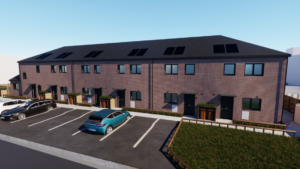Mixed communities and right to buy: bang to rights?
Mixed communities as a phrase, as an outcome and as a specific government sponsored approach to regeneration has rather disappeared from polite policy circles. It seems to belong firmly to the period before the new dispensation. Although some of the new turns out to be quite old. Take right to buy for example.
Both mixed communities and right to buy share an interest in aspiration: stimulating it or purportedly rewarding it. But what does either offer in terms of improving the life chances of existing residents?
Boiled down, the aims of mixed communities were familiar: new affordable housing; small area regeneration; and benefits for existing residents.
More contentious was the specific approach sponsored by the Labour government with the explicit aim of breaking up ‘concentrations’ of deprivation to change the housing market function of the area: major physical redevelopment; a significant increase in the proportion of higher income groups; using private finance to cross subsidise the development of more affordable housing. This was complicated and expensive and even in the US where conditions arguably made such approaches more relevant they had fallen far short of their ambitions.
‘Mixed communities’ was also bedevilled by confusion, in particular between mix as an outcome in itself and as an instrumental mechanism to secure change for an area and for individuals.
Evaluation of demonstration projects suggested that more housing mix did have potential to improve the perception of an area and make it a better place to live (when allied to other familiar interventions).
However, the degree to which more interaction between social groups produced benefits for individuals in terms of improving their life chances was at best unproven and any effect was likely to be much less significant than wider household factors.
Further confusion also arose about whether any of this purported improvement in area effects arose from changes in tenure or changes in income mix. The cosy assumption was that the two went hand in hand.
Clearly if changes in tenure were the primary aim then right to buy would knock any mixed community policy into a cocked hat. And RTB is back: bigger and better than ever and keen to reward individual aspiration to own a home.
As discussion on The Guardian’s housing network has amply demonstrated, we actually know very little about the effect of RTB beyond a massive reduction in the availability of social housing. We don’t know how many purchasers stay in their homes for life, what happens in terms of succession, or (crucially) whether there are substantive changes in wealth or any link with wider opportunities. What we do know is that RTB owners were twice as likely as others to have difficulties in maintaining their mortgage payments and have a high incidence of multiple loans secured against the property.
We don’t know how many RTB properties have or will end up in the buy to let market with the result that in practice they stoke further residualisation with new tenants who are transient, low paid and reliant on housing benefit.
We can entertain some scepticism that the new policy will see genuine one for one provision of social housing. Many will end up as ‘affordable rent’ properties; in practice a different form of tenure.
We can also envisage that a free market approach like RTB is most unlikely to secure the kind of mix that might really start to make more attractive places. This market failure was explicitly recognised in the original thinking behind mixed communities.
Either way it seems most likely that the thing most desired by the inhabitants of the mixed community demonstration projects areas – more social housing for rent – will not come to pass.
So if it’s more (genuinely) affordable housing and real change in life chances for existing residents one might say that these aspiration based policies have all been caught bang to rights.
Almost inexorably one comes back to the point that many poor people live in poor neighbourhoods because they cannot afford to live elsewhere. It is other factors that make them poor. Seeing their neighbours buy their houses and perhaps struggle to maintain a mortgage or having a wealthier incomer living in a shiny new flat nearby won’t in itself do a lot for them.
Perhaps it’s just as well that we don’t talk about mixed communities these days.
Photo by KARL-SEBASTIAN SCHULTE 
Photo by KARL-SEBASTIAN SCHULTE 















